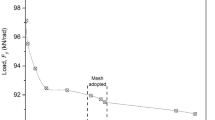Abstract
Piping erosion-induced earthen structure failures can cause catastrophic consequences and great economic loss. Experimental laboratory simulation of piping plays a key role for the study of eroded soils. Up till now, piping erosion has been simulated in different ways, such as artificial slot or drilled hole. This paper is a continuation of such efforts and presents a new method of reproducing piping erosion by dissolution of preinstalled glucose column inside the tested material. The proposed method was examined through a series of triaxial compression tests under different densities and confining pressures, aiming to identify the association between stiffness loss and particle dissolution during piping erosion. With the help of local sensors, volumetric strains during piping propagation and small strain stiffness of soil at post-erosion state were obtained. Results showed significant degradation of Young’s modulus and Poisson’s ratio in soil subjected to piping erosion, while the overall shear strength of the disturbed specimens appeared to be less affected.











Similar content being viewed by others
References
Acciardi RG (1982) Quantification of pinhole test equipment by hydraulic characteristics. U.S. Bureau of Reclamation, Denver, CO, technical report REC-ERC-82-15
Arulanandan K, Loganathan P, Krone R (1975) Pore and eroding fluid influences on surface erosion of soil. J Geotech Div ASCE 101(GT1):51–66
Arulanandan K, Gillogley E, Tully R (1980) Development of a quantitative method to predict critical shear stress and rate of erosion of natural undisturbed cohesive soils. Technical report GL-80-5, U.S. Army Engineers, Waterways Experiment Station, Vicksburg, MS
Chapuis RP, Gatien T (1986) An improved rotating cylinder technique for quantitative measurements of the scour resistance of clays. Can Geotech J 23:83–87
Emerson WW (1964) The slaking of soil crumbs as influenced by day mineral composition. J Soil Res 2:211–217
Emerson WW (1967) A classification of soil aggregates based on their coherence in water. Aust J Soil Res 5:47–57
Fam MA, Cascante G, Dusseault MB (2002) Large and small strain properties of sands subjected to local void increase. J Geotech Geoenviron Eng 128(12):1018–1025
Foster MA, Fell R, Spannangle M (2000) The statistic of embankment dam failures and accidents. Can Geotech J 37(5):100–124
Goto S, Tatsuoka F, Shibuya S, Kim YS, Sato T (1991) A simple gauge for local small strain measurements in the laboratory. Soils Found 31(1):169–180
Hardin BO, Richart FE Jr (1963) Elastic wave velocities in granular soils. Soil Mech Found Div ASCE 89(1):33–65
ICOLD (2013) Internal erosion of existing dams, levees and dikes, and their foundations. Volume 1: internal erosion processes and engineering assessment. Bulletin 164, International Commission on Large Dams (ICOLD), Paris, France
Kelly D, McDougall J, Barreto D (2012) Effect of particle loss on soil behavior. In: Proceedings of 6th international conference on scour and erosion, pp 639–646
Lefebvre G, Karol R, Douville S (1985) Erosivity of naturel intact structured clay: evaluation. Can Geotech J 22:508–517
Luo YL, Qiao L, Liu XX, Zhan ML, Sheng JC (2013) Hydro-mechanical experiments on suffusion under long-term large hydraulic heads. Nat Hazards 65(3):1361–1377
McDougall J, Kelly D, Barreto D (2013) Particle loss and volume change on dissolution: experimental results and analysis of particle size and amount effects. Acta Geotech 8(6):619–627
Moore WL, Masch FD Jr (1962) Experiments on the scour resistance of cohesive sediments. J Geophys Res 67(4):1437–1449
Renuka IHS, Kuwano R (2011) Formation and evaluation of loosened ground above a cavity by laboratory model tests with uniform sand. In: Proceedings of 13th international summer symposium, pp 211–214
Rohan K, Lefebvre G, Douville S, Milette J-P (1986) A new technique to evaluate erosivity of cohesive material. Geotech Test J 2(9):87–92
Sato M, Kuwano R (2016) Effects of internal erosion on mechanical properties evaluated by triaxial compression tests. In: Proceedings of the 15th Asian regional conference on soil mechanics and geotechnical engineering, pp 1056–1059
Sherard JL, Dunnigan LP, Decker RS, Steele EF (1976) Pinhole test for identifying dispersive soils. J Geotech Eng Div ASCE 102(GTI):69–85
Shin H, Santamarina JC (2009) Mineral dissolution and the evolution of k0. J Geotech Geoenviron Eng 134(8):1141–1147
Tatsuoka F, Teachavorasinskun S, Dong J, Kohata Y, Sato T (1994) Importance of measuring local strains in cyclic triaxial tests on granular materials. In: Ebelhar RJ, Drnevich VP, Kutter BL (eds) Dynamic geotechnical testing II. ASTM STP 1213, West Conshohocken
Truong QH, Eom YH, Lee JS (2010) Stiffness characteristics of soluble mixtures. Géotechnique 60(4):293–297
Wan CF, Fell R (2002) Investigation of internal erosion and piping of soils in embankment dams by the soil slot erosion test and the hole erosion test. University of New South Wales, School of Civil and Environmental Engineering, Kensington
Wan CF, Fell R (2004) Investigation of rate of erosion of soils in embankment dams. J Geotech Geoenviron Eng 4(30):373–380
Acknowledgements
The experiments presented in this paper were performed in the Department of Civil Engineering at the University of Tokyo. The authors would like to thank Mr. Takeshi Sato from Integrated Geotechnology Institute Ltd. for his indispensable assistance in the apparatus. This research was financially supported by the National Natural Science Foundation of China under Grant No. 51609171, and the National Key Research and Development Program of China (2016YFE0105800).
Author information
Authors and Affiliations
Corresponding author
Rights and permissions
About this article
Cite this article
Yang, Y., Kuwano, R. & Xu, C. A preliminary study on the piping erosion of soils using glucose dissolution method. Environ Earth Sci 77, 31 (2018). https://doi.org/10.1007/s12665-017-7191-7
Received:
Accepted:
Published:
DOI: https://doi.org/10.1007/s12665-017-7191-7




